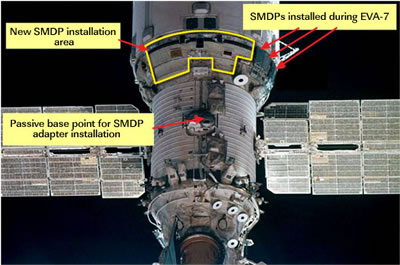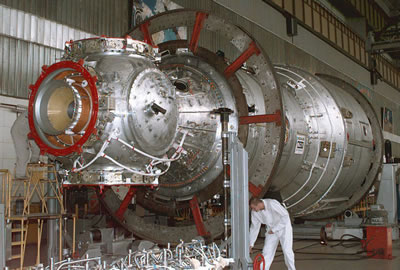Science Fiction
Dictionary
A B C D E F G H I J K L M N O P Q R S T U V W X Y Z
Space Station Gets Shielding, Not Blasters

Russian cosmonauts climbed out of the International Space Station on Wednesday afternoon to install protective panels. Commander Fyodor Yurchikhin and flight engineer Oleg Kotov completed the planned work five hours later. The spacewalk was delayed due to problems encountered during communication checks. The 17 protective panels, each about 2 feet by 3 feet and weighing about 20 pounds, were delivered to the station last December.
The plan is for Kotov to retrieve three bundles of Service Module Debris Protection Panels and then attach them to the Zvezda Service Module. Zvezda provides some of the station's life support systems, as well as living quarters for two crewmen with a treadmill and a bicycle for exercise. A second spacewalk planned for June 6th will complete the installation.

(SMDP installation locations on Zvezda)
NASA engineers are concerned that space debris, in the form of everything from rocket parts to Chinese ASAT test debris to dropped wrenches, will damage the ISS. It will be possible to turn the ISS slightly to present a shield to oncoming debris, assuming that the object is big enough to be tracked.

(Zvezda under construction)
Science fiction writers have been working on protection for spacecraft for generations now, and frankly, nobody's interested in those passive bolt-on panels. To paraphrase Han Solo, panels are fine but they're "no match for a good blaster at your side."
In his 1945 classic First Contact, writer Murray Leinster puts his money on blasters as the best way to deal with any object large enough to damage your ship.
The blasters are those beams of ravening destruction which take care of recalcitrant meteorites in a ship's course when the deflectors can't handle them. They are not designed as weapons, but they can serve as pretty good ones. They can go into action at five thousand miles, and draw on the entire power output of a whole ship. With automatic aim and a traverse of five degrees, a ship like the Llanvabon can come very close to blasting a whole through a small-sized asteroid which gets in the way.
(Read more about meteor blasters)
I know it's a lot of extra work, but it gives you a better ride than those deflector shields that George Lucas suggests. If you didn't mind using a bit of propellant, you could try the solution that George O. Smith suggests in his 1943 story Recoil - meteor-spotting radar:
Spacecraft were protected from meteors by means of radar that was coupled to the steering panels of the ships; when a meteor threatened, the ship merely turned aside by that fraction of a degree that gave it safety.
(Read more about meteor-spotting radar)
But then, of course, you don't get to use your blasters.
Read about the origin of the sf term "blaster." Read more about the space walk at ISS Mission Update and NASA.
Scroll down for more stories in the same category. (Story submitted 5/30/2007)
Follow this kind of news @Technovelgy.| Email | RSS | Blog It | Stumble | del.icio.us | Digg | Reddit |
Would
you like to contribute a story tip?
It's easy:
Get the URL of the story, and the related sf author, and add
it here.
Comment/Join discussion ( 2 )
Related News Stories - (" Space Tech ")
Will Space Stations Have Large Interior Spaces Again?
'They filed clumsily into the battleroom, like children in a swimming pool for the first time, clinging to the handholds along the side.' - Orson Scott Card, 1985.
Reflect Orbital Offers 'Sunlight on Demand' And Light Pollution
'I don't have to tell you about the seven two-mile-diameter orbital mirrors...'
Chrysalis Generation Ship to Alpha Centauri
'This was their world, their planet ó
this swift-traveling, yet seemingly moveless vessel.' - Nat Schachner, 1934
The First Space Warship For Space Force
'Each of the electrical ships carried about twenty men...' - Garrett P. Serviss, 1898.
Technovelgy (that's tech-novel-gee!) is devoted to the creative science inventions and ideas of sf authors. Look for the Invention Category that interests you, the Glossary, the Invention Timeline, or see what's New.
Science Fiction
Timeline
1600-1899
1900-1939
1940's 1950's
1960's 1970's
1980's 1990's
2000's 2010's
Current News
Golf Ball Test Robot Wears Them Out
"The robot solemnly hit a ball against the wall, picked it up and teed it, hit it again, over and again...'
Boring Company Vegas Loop Like Asimov Said
'There was a wall ahead... It was riddled with holes that were the mouths of tunnels.'
Rigid Metallic Clothing From Science Fiction To You
'...support the interior human structure against Jupiterís pull.'
Is The Seattle Ultrasonics C-200 A Heinlein Vibroblade?
'It ain't a vibroblade. It's steel. Messy.'
Roborock Saros Z70 Is A Robot Vacuum With An Arm
'Anything larger than a BB shot it picked up and placed in a tray...'
A Beautiful Visualization Of Compact Food
'The German chemists have discovered how to supply the needed elements in compact, undiluted form...'
Bone-Building Drug Evenity Approved
'Compounds devised by the biochemists for the rapid building of bone...'
Secret Kill Switch Found In Yutong Buses
'The car faltered as the external command came to brake...'
Inmotion Electric Unicycle In Combat
'It is about the size and shape of a kitchen stool, gyro-stabilized...'
Grok Scores Best In Psychological Tests
'Try to find out how he ticks...'
PaXini Supersensitive Robot Fingers
'My fingers are not that sensitive...'
Congress Considers Automatic Emergency Braking, One Hundred Years Too Late
'The greatest problem of all was the elimination of the human element of braking together with its inevitable time lag.'
The Desert Ship Sailed In Imagination
'Across the ancient sea floor a dozen tall, blue-sailed Martian sand ships floated, like blue smoke.'
The Zapata Air Scooter Would Be Great In A Science Fiction Story
'Betty's slapdash style.'
Thermostabilized Wet Meat Product (NASA Prototype)
There are no orbiting Michelin stars. Yet.
Could Crystal Batteries Generate Power For Centuries?
'Power could be compressed thus into an inch-square cube of what looked like blue-white ice'
